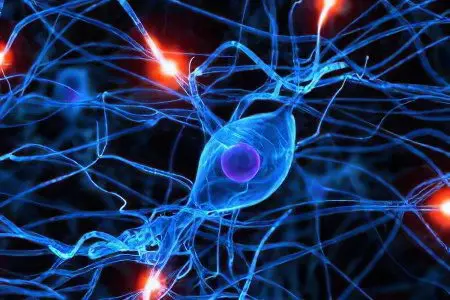Contents

Neuropathy is a non-inflammatory disorder of the nerves. The name combines various degenerative-dystrophic changes in peripheral nerves. The nervous system is formed by peripheral nerves and various nerve plexuses, the brain and spinal cord.
Peripheral nerves, having a thin and at the same time complex structure, are unstable to damaging processes. There are mononeuropathy, which means damage to one nerve, multiple mononeuropathy, in which several nerves are involved in the process, but in different parts of the body, and polyneuropathy with the involvement of several nerves and localization in one zone.
Causes of neuropathy
Neuropathy is determined by the location and nature of nerve damage. Usually the disease develops after the transfer of common diseases, with some intoxications, due to various injuries.
There are three forms of neuropathy:
Diabetic neuropathy – This is a lesion of nerve fibers and the smallest vessels with a high content of sugar and lipids in the blood.
Toxic neuropathy – the cause is nerve damage in infectious diseases, among which diphtheria, HIV, herpes, etc. are noted. Chemical poisoning and unmetered intake of certain medications disrupt the normal state of the nerve trunks.
Post traumatic – often a strong blow or other acute injury leads to a violation of the integrity of the myelin sheath of the nerve. This form is the result of compression of nerve fibers during bone fracture, improper scarring and tissue swelling. The most common lesions are the sciatic, ulnar and radial nerves.
Quite often, the development of neuropathy is provoked by arthritis, osteochondrosis of the spine, liver and kidney diseases, insufficient levels of thyroid hormones in the body, tumors, etc.
Symptoms of neuropathy
As a result of nerve damage, thinning of muscle tissue and a violation of their reflex function are possible. There is also a change in contractility, a partial loss of sensitivity to stimuli that cause pain. The manifestations of neuropathy can be very diverse, the pathology process can be localized anywhere and cause, for example, neuropathy of the facial nerve, trigeminal nerve, etc. The motor, sensory or autonomic function of the nerve is affected, which reduces the quality of life. Most people diagnosed with diabetes may have several forms of neuropathy:
Peripheral form of neuropathy, i.e., damage to the nerves that innervate the upper or lower limbs. In this case, there is a feeling of tingling on the side of the affected nerve, a violation of the sensitivity of the fingers and toes, a feeling of numbness.
The proximal form is defined by impaired sensation in the legs, in particular in the lower leg, thigh or buttock.
The autonomous form disrupts the activity of the digestive organs and the genitourinary system.
Diagnosis of neuropathy
Neuropathy is a rather complex disease, so the history must be taken especially carefully, since such a disease can develop for a long time without showing symptoms. It is especially important to note whether viral diseases were present, what new drugs might have been taken, and whether there was contact with chemicals.
The disease can provoke alcohol abuse, the presence of a systemic disease. Based on many facts, the diagnosis is established. Neuropathies proceed in different ways with rapidly increasing symptoms, over several days or years. The disease is diagnosed by palpation of the nerve trunks, the presence of thickening is detected. A Tinel test is carried out, a method that consists in tapping along the nerve trunk, if the patient feels a tingling in the zone of sensitive innervation, then the diagnosis is confirmed.
Traditionally, when examining polyneuropathy, blood is examined by determining the ESR. Also in the diagnostic complex include chest x-ray, measure the level of plasma glucose after eating. Serum protein electrophoresis is performed.
Treatment

Treatment of non-inflammatory nerve lesions is selected individually and requires an integrated approach and ongoing prevention.
Methods and methods of therapy are selected depending on the degree, form and causes that contribute to the violation of the conduction of nerve fibers. All efforts are aimed at restoring the functions of the nerve. The diagnosis of nerve damage of a toxic nature primarily implies the elimination of toxic effects. This may be the abolition of the drug, the exclusion of the use of toxic substances.
In the diabetic form, it is necessary to maintain normal blood sugar levels. If a post-traumatic form of nerve fiber damage is detected, it is recommended to eliminate the traumatic factor. Necessarily, the complex of treatment should consist of taking painkillers, vitamins of certain groups, drugs that normalize metabolism and enhance regenerative ability.
Physiotherapy procedures are also prescribed. Prevention of neuropathy includes the restoration of metabolic processes, timely treatment of systemic and infectious diseases. It should also be borne in mind that this disease can go into a chronic stage, so it is advisable to take all necessary measures to prevent exacerbation.
Patients with such disorders, with a decrease in perceptible symptoms of the disease and a possible chronic process, benefit from spa treatment. Where they are prescribed psychotherapeutic procedures, acupuncture, exercise therapy and massage, magnetotherapy, light and laser treatment, aromaphytotherapy.
Prevention of neuropathy
Prevention of neuropathy is the care of each person about their health. A healthy lifestyle, regular exercise allows you to improve blood microcirculation in the limbs and other parts of the body. It is also important to prevent complications of neuropathy. Avoid injuries and burns to the hands and feet, wash and examine parts of the body daily, and if there are any changes, consult a doctor.
It is useful to take foot baths for 15 minutes, rub and lubricate with petroleum jelly. Comfortable shoes and timely removal of corns should be. It is recommended to take keratolytic agents.









